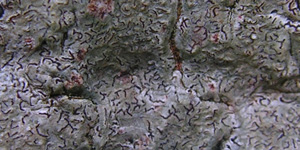Savernake Forest, North Wiltshire, Saturday, 12th February 2011
The aim of this meeting was to follow up on a record of the rarely found Lecanora sublivescens NT (NS/IR/BAP) from an old Beech made on 14/10/1989 by Ken Sandell and me at SU223 682 in the north of Savernake Forest. I had not refound this species here during a contract survey in March 2007 for Natural England. This survey had been a race around the Forest on a bicycle, visiting all the mapped veteran trees. This had produced the first comprehensive map of the lichen interest, but left plenty of more detailed searching to do on some of the richer areas. I had actually found one location for Lecanora sublivescens in 2007, on an Oak near the tree nursery the south, but no others.
We met at the main car park to the west, with eight people attending (Neil Sanderson leading, with Lesley Balfe, Michael Balfe, Andy Cross, Ken Sandell, Malcolm Storey, Amanada Waterfield & Tim Wilkins), in sunny weather after much rain. We double up in cars and headed over to the small car park Stitchcombe, off the London Road (SU224 683). We were north east of the grid reference for the Lecanora sublivescens but also east of an avenue of Beech, which was noted as the richest beech in the 2007 survey. Ken remembered that we had found the Lecanora sublivescens to the east so we went there first. I was interest to have a closer look at the Beech, which is said not to be native and is quite species poor in large areas of the Forest.
We started recording on the Beech straightway, with the old woodland species Mycoporum antecellens and Thelotrema lepadinum along with Strigula taylorii Nb (NS/IR) in a wound track. The latter species was not seen in 2007. We also got into a discussion on distinguishing Lecanora expallens and Pyrrhospora quernea, one conclusion was that we all had slightly different concepts of these species. The eventual conclusion was that the colour of Pyrrhospora quernea could be a bit more variable than some were expecting. The best guide is soredia size, which is coarser on Pyrrhospora quernea than Lecanora expallens, but the former is usually darker yellow and Lecanora expallens is fairly consistently pale yellow. In lower nitrogen deposition environments Lecanora expallens is mainly a species of dry bark. Only with increased nitrogen deposition does it get common on moister bark.
Mycoporum antecellens on Beech
Across the side road, Tim Wilkins, demonstrated that you do not need an expensive swiss illuminated LED hand lens to find small pinheads. At SU22406 68275, he found Chaenotheca hispidula Nb (NS) in a crack in the bark of an Oak with his much cheaper LED hand lens. This is a lovely little species with yellow pruina under the head (although I think some people found it easier to see this in Malcolm Storey’s photograph!) and is on Trentepohlia algae. We worked along the Beech avenue to a cross road, where there was a Beech (SU22526 68295 ±5m, Tag 5793) with wound tracks. These were still wet but on one side I found some black disks with a bit of green associated thallus, which I thought might be Bacidia incompta VU (NS/BAP), which would have been a good find. On the other side I found some more drier black disks with less thallus, which I thought might be Catillaria nigroclavata Nb (NS). Collecting little bits of both, however, latter showed that I only had Catillaria nigroclavata Nb (NS), the wet apothecia had been misleading. I least I got it half right!
Beeches to the east
Further on, after lunch, we found some magnificent material of Calicium glaucellum on a dead Oak and, at SU22652 68275 ±7m, the pretty little pinhead Chaenotheca brachypoda Nb (NS) was found on a dead Beech with Opegrapha ochrocheila. The latter had its orange K + crimson pruina well developed. One impressive Beech (SU22830 68269 ±6m had a base rich flushed streak with Normandina pulchella, Pachyphiale carneola and Pyrenula chlorospila. One curious feature was that on trees tagged with galvanised tree tags and that some of these had zinc contaminated streaks below them, which were dominated by the local Lecania cyrtellina, not something I had not seen before.
We still had not found the Lecanora sublivescens tree and turned around back to the cars and headed off west towards the original six figure grid reference (SU223 682). Scouting along a row of Beech in this area did eventually find the original tree at SU22228 68190 ±6m (tag 6035), about 70m from the original grid reference, not bad for a pre GPS grid reference. Sadly the tree was dead, but a little Lecanora sublivescens NT (NS/IR/BAP) was refound. There was also Arthonia cinnabarina and Chaenotheca brachypoda Nb (NS).
Lecanora sublivescens
Finally we finished the day looking at a group of old Oaks (SU22270 68125 ±7m), the main habitat of lichen interest in Savernake Forest. Here yet more pinheads were found, with Chaenotheca brunneola and Microcalicium ahlneri Nb (NS) on standing lignum and Chaenotheca ferruginea and Chaenotheca trichialis on bark. Fallen damper wood supported Cladonia digitata and Cladonia parasitica, while the bark had Arthonia vinosa and Opegrapha corticola Nb (IR).
The Oak grove
We had a relaxed day’s lichen recording in a less well known part of Savernake Forest. We did refind the target species but found the tree was dead and the lichen, Lecanora sublivescens, not found on any other tree, symptomatic of the problems of this site, which has one of the worst generation gaps I have seen in an important lichen site. We recorded 71 taxa (Species List), of which nine were new to the site. We refound one Near Threatened species and five Notable species and scored 9 on the NIEC ancient woodland index (with 11 NIEC species seen).
To see the route taken click on the text below.



